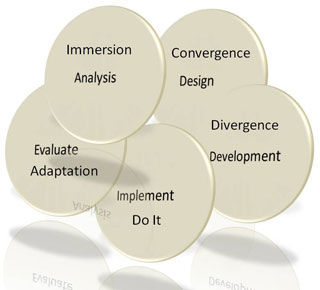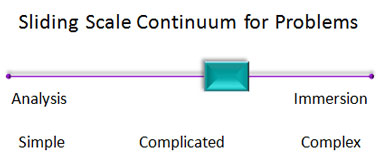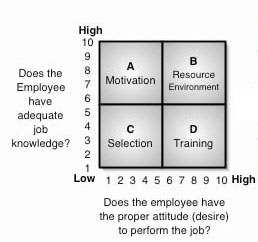 In my last post I discussed Innovating With ADDIE by using the X Problem Solving Framework of Immersion, Convergence, Divergence, and Adaptation in conjunction with ADDIE. In this post I'm going to elaborate on the first step of the framework — Immersion and Analysis:
In my last post I discussed Innovating With ADDIE by using the X Problem Solving Framework of Immersion, Convergence, Divergence, and Adaptation in conjunction with ADDIE. In this post I'm going to elaborate on the first step of the framework — Immersion and Analysis:

When presented with performance or learning challenges there is a continuum on how to approach the problem that is composed of analysis on one end of the scale and immersion on the other end.

Allison Rossett & Kendra Sheldon defined Analysis as “the study we do in order to figure things out” (Beyond the Podium: Delivering Training and Performance to a Digital World ). This term is normally associated with the traditional steps of analysis, such as performing a needs assessment, task analysis, and building performance measures.
While on the other end of the continuum is immersion. It is defined by Adam Richardson of Frog Design as “the method of soaking yourself in understanding what the problem is that you are facing in addition to informing the other three parts of the framework.” This can be thought of jumping into the problem in order to understand it, but not being able to use traditional analysis tools or instruments due to the complexity of the problem.
In most learning or performance design situations we don't use one or the other but rather a mixture of the two, thus it is a Sliding Scale Continuum:
For example:
Left of Continuum
Simple problems will be composed mostly of analysis because we have Exemplary Performers that we can use for models. While this is normally one of the easier learning platforms to design, it does have a couple of pitfalls. The first is thinking that since it is fairly easy to design, it is also easy to learn and perform, thus we fail to build practice time into the learning platform. Designers often become so absorbed in their work that they fail to realize how much time they are putting into it, thus they spend weeks working on the task, then think they can transform it into a 30 minute information dump. The second pitfall is failing to support the informal learning that must occur after the formal learning because there is an average of a 1:4 ratio in which one hour of formal learning produces four-hours of informal learning.
Middle of Continuum
As we move to more complicated design environments there is no Exemplary Performers to be found, thus we have to rely on our own understanding of the problem and other experts who have knowledge of the type of problem you are trying to solve. Thus we are moving towards the middle of the continuum:
- We are doing analysis in that we are interviewing experts to create a best practice.
- In addition, we are immersing ourselves into the environment of those most affected by the learning solution in order to complete our understanding of the problem that the experts cannot elaborate on.
Like the simple environment, you will have to watch for the two pitfalls; in addition, in this complicated learning environment you will normally perform more sets of iterations to ensure you get the feedback of those affected.
Right of Continuum
As we move farther to the right on the scale to complex learning design environments there are no Exemplary Performers and few or no experts to draw upon, thus we get most of our information by totally immersing ourselves into the environment of those most affected by the problem in order to “paint a picture of an emergent practice.” This is because as Rittel (1972) discovered — the best experts within these types of environments are those affected by the solution — since they are the only ones to have experienced the complexity of the problem, they are the best experts for helping to improve that environment.
You need to look for solutions that support informal learning. This is because the complexity of such environments normally needs a small seed of formal learning with large nourishments of informal learning.
Performance Model
In addition, a performance model (such as the one shown below and I discussed in this post) acts differently in the continuum of analysis and immersion.

That is, when you are presented with a problem that is mostly on the analysis side of the continuum, the type of performance problem will normally become apparent within a short time and it will be more of a simple nature. However, as the problem starts to move to the immersion side of the continuum, you will find yourself having to dig deeper and longer to discover the true nature of the problem. In addition, rather than being a simple problem, it will normally be composed of several parts that require multiple solutions, such as fixing a process, creating a learning environment, and redesigning work stations.
Next
Thus, when presented with performance problems we have to think along the scale or continuum of Immersion and Analysis, depending upon the complexity of the problem.
In my next post we will discuss the Sliding Scale Continuum of Planning that is composed of Design on one end and Convergence on the other end.
Reference
Rittel, H. (1972). On the planning crisis: Systems analysis of the “first and second generation.” Bedriftsokonomen. No. 8, pp.390-396.
1 comment:
As I looked around this site I found myself shaking my head over the jumble of abstract terms that must drive a new Instructional Designer running to find another career. I've never witnessed anything like it in over forty years of doing instructional design. Do the posters actually believe they are presenting useful ISD process? If they do, they are as wrong as anyone can be. So sad, the ISD process is much simpler and linear even with the most complex performance problems. But you must begin with concrete (not abstract) terms and concepts. This is lacking in everything, including the block diagrams here. Using such spaghetti logic, how they are able to convince a client of the relevance of the approach and cost-benefit details is beyond my comprehension.
Post a Comment